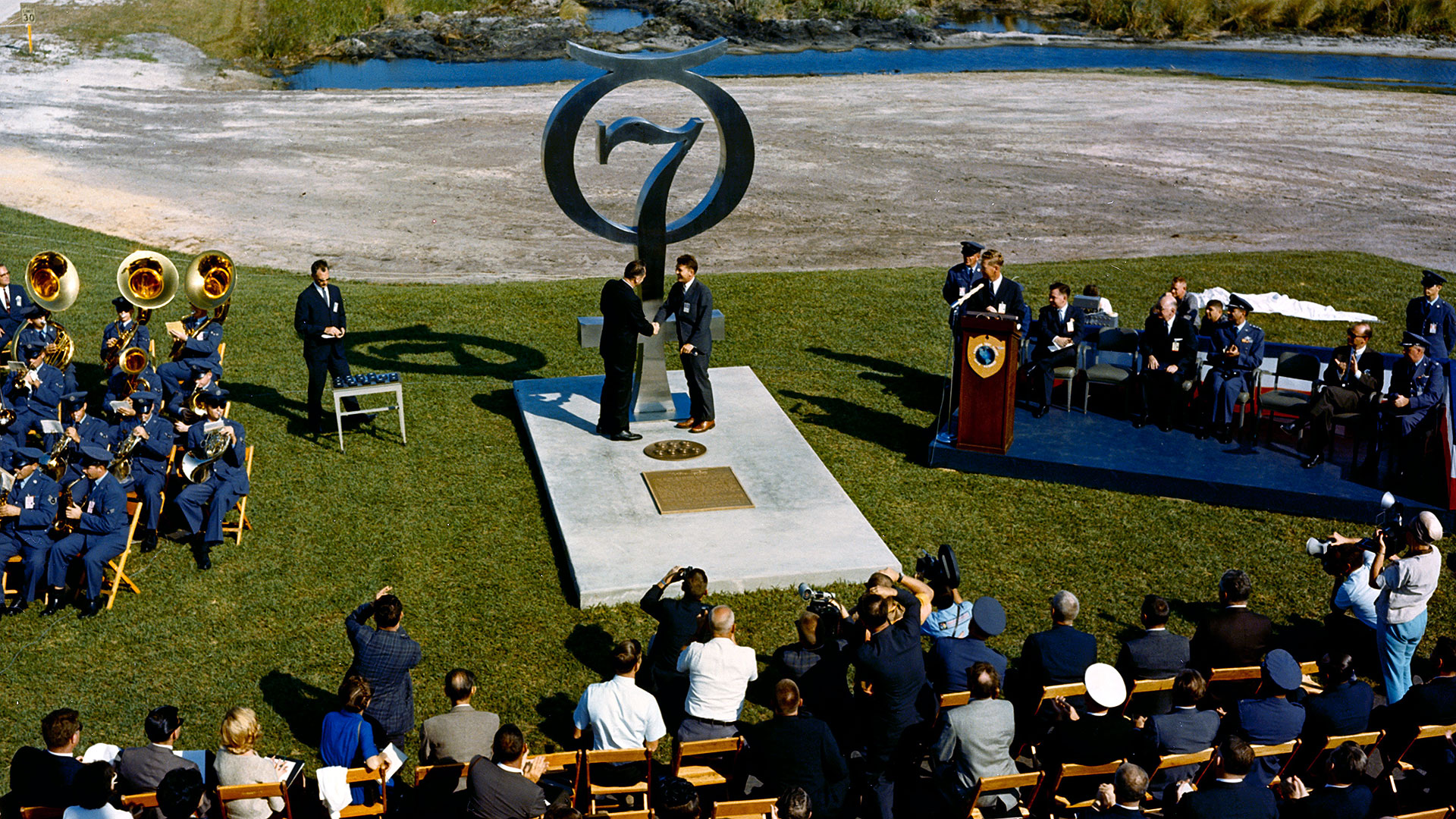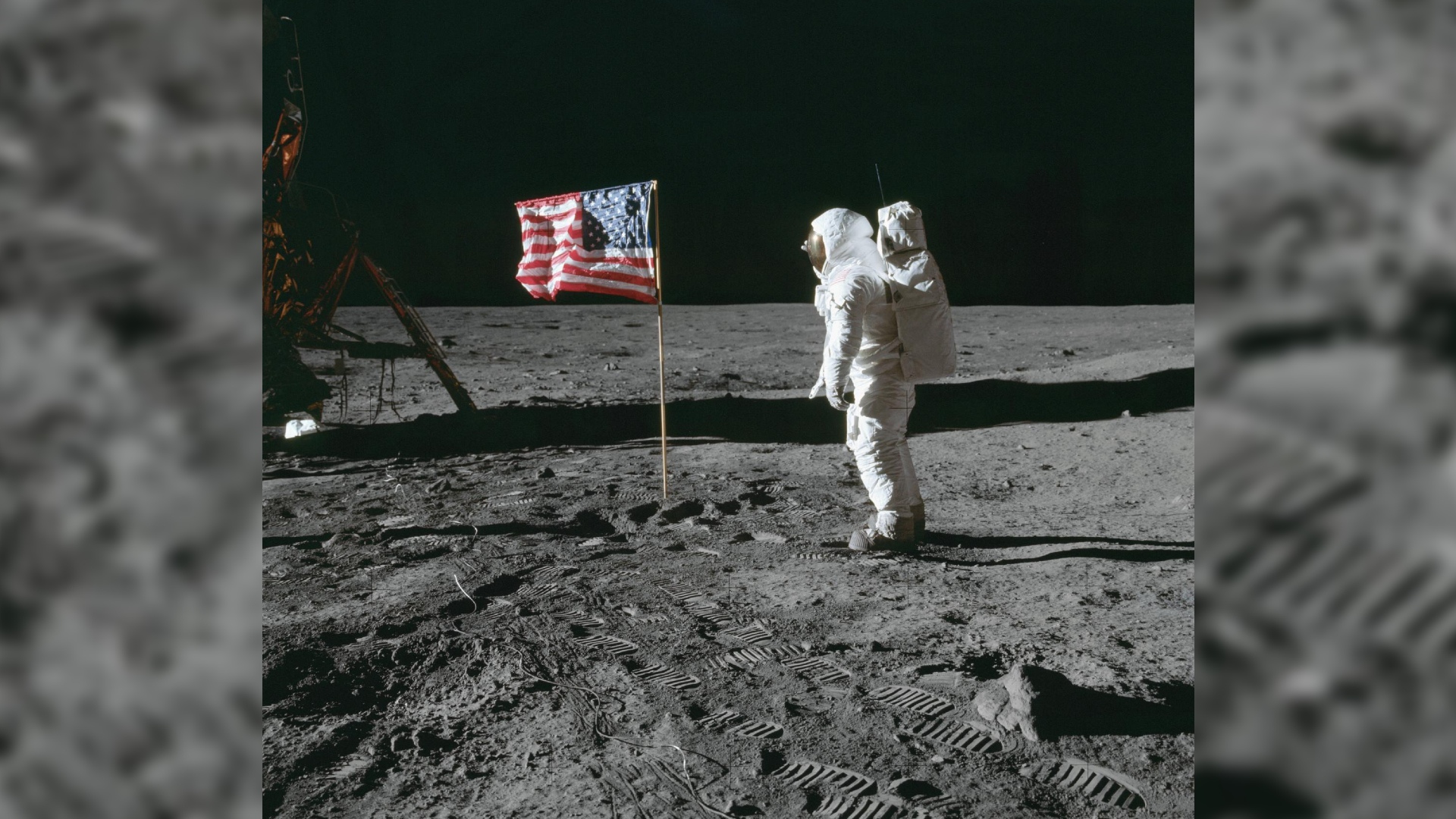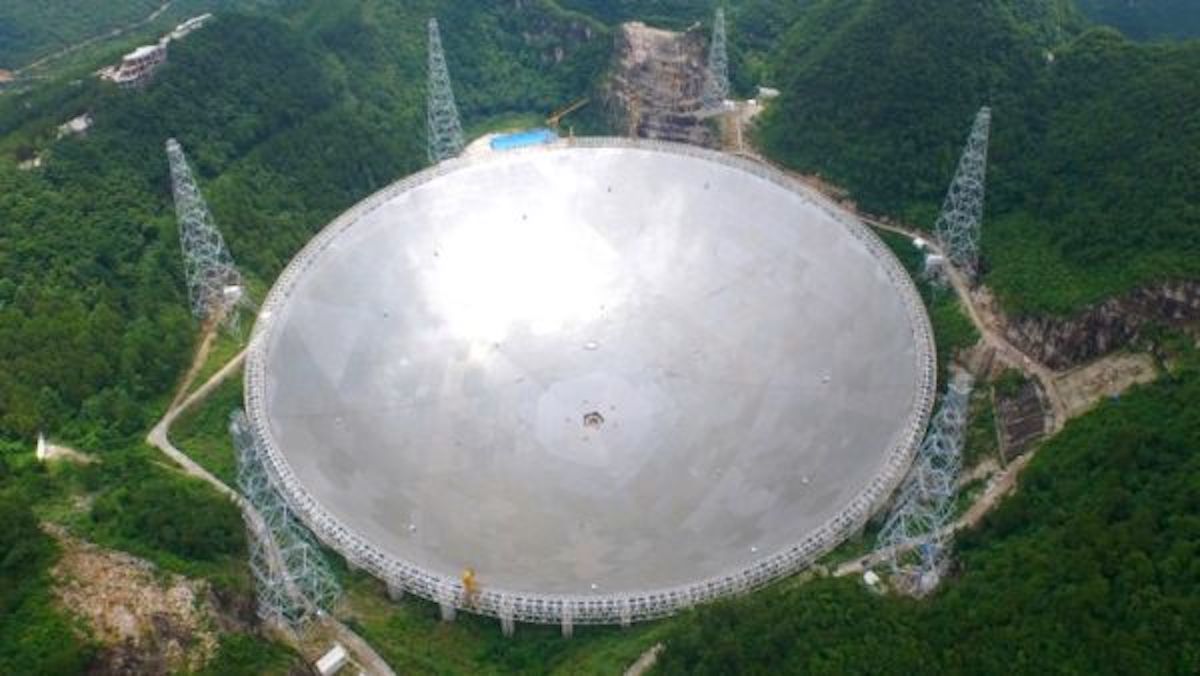A 60-year-old tribute to America’s first human spaceflight program is standing up to the test of time, but what about the contents of its time capsule not to be opened until 2464?
The Project Mercury Monument located at the Cape Canaveral launch pad from where NASA astronauts first flew into Earth orbit was dedicated on Nov. 10, 1964 “to the thousands of men and women of the free world who contributed to the success” of the United States’ “pioneering man-in-space program.” The primary feature of the installation is a 13-foot-tall (4 meters) sculpture of the symbol for the planet Mercury with the number “7” at its center representing the nation’s original seven astronauts.
The symbol was made by Washington Steel of Pennsylvania using the same metal alloy as the company developed for the Atlas rockets that launched four of NASA’s Mercury astronauts from Launch Complex-14 (LC-14).
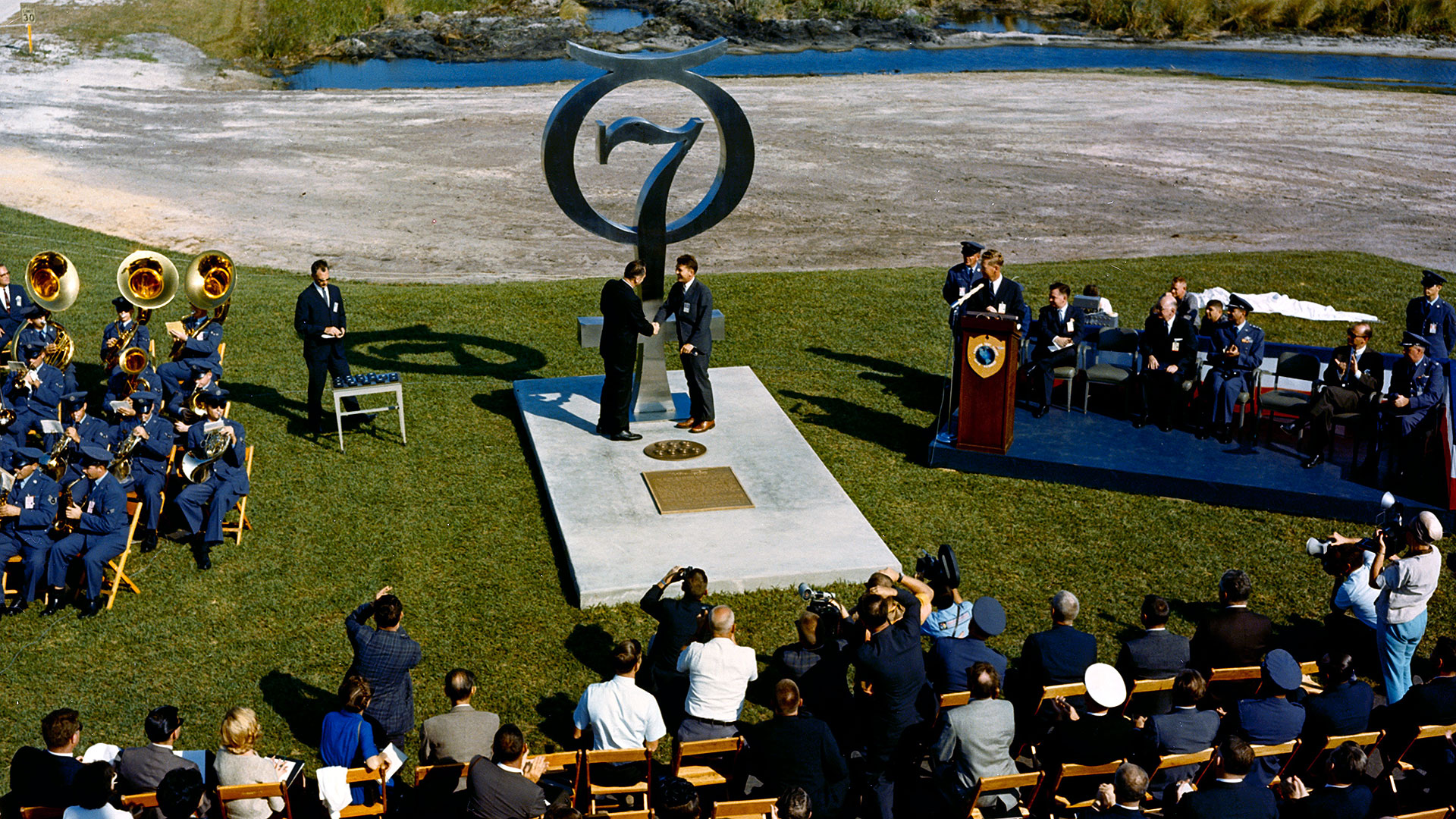
“The monument is standing up surprisingly very well,” said James Draper, director of the Cape Canaveral Space Force Museum, in an interview with collectSPACE.com. “The Cape Canaveral Space Force Station is one of the worst preservation environments in the world. We contend with challenges every day out here at the museum. We have intense sun; the salty ocean breeze — not only salty, but ionized; bad and intense tropical storms; exotic pests; and high humidity. All kinds of things that don’t bode well for the preservation of anything.”
“I’m astonished with the preservation of the Mercury monument,” said Draper. “So whatever that steel is, it’s some sort of miracle metal. I have inspected it fairly thoroughly and can’t find any active corrosion or rust, while everything else on the Cape rots without significant attention.”
Related: Project Mercury: America’s 1st crewed space program
500 years
Encased in the monument’s concrete base is a time capsule containing technical reports, photos, recordings and other memorabilia related to Project Mercury. The sealed metal box is not to be opened until 2464, 500 years after the monument’s dedication.
“I’m a little skeptical to believe there’s much integrity left to a lot of the materials that are in that time capsule,” said Draper. “Now, if that box is made of that same ‘miracle’ steel, there is a possibility that things are fairly well protected from the exterior elements of Florida, but I will guarantee you that they are not protected from the inherent vice of the materials themselves.”

“Wood, pulp, paper materials, films and photographic prints are all inherently unstable pieces that I guarantee, even if they did a nitrogen swab and sealed it so that Godzilla himself couldn’t pry it open, the materials inside will eat themselves up over the course of 500 years,” he said.
The items placed inside the time capsule were first sealed within “special plastic containers,” according to documents from General Dynamics, the company that organized and underwrote the creation of the monument. Twenty-six still photos showing highlights from the Mercury program were “specially prepared” following the advice of the Eastman Kodak Company and the American Standards Association.
Other contents included (skip ahead now if you want to be surprised in 440 years):
- Proceedings of the Mercury-Atlas Booster Reliability Workshop conducted in San Diego, California on July 12 1963;
- The results of the first, second and third crewed orbital spaceflights, as well an overview of the entire Mercury project, including the fourth orbital flight;
- James Grimwood’s “Project Mercury: A Chronology,” published in 1963;
- Proceedings from a 1960 review of the space program held before the Committee on Science and Astronautics in the House of Representatives; a report on Project Mercury prepared by the same committee in 1961; and a 1962 report to the U.S. Congress on the status of the Mercury, Gemini and Apollo programs;
- A hardcover copy of “We Seven: By the Astronauts Themselves,” published by Simon & Schuster in 1962;
- “Aeronautics: Past and Future” by J.R. Dempsey, president of General Dynamics and a collection of prophecies by “distinguished Americans of man’s employment in space in 2063 A.D.” as compiled for the fifth anniversary of the dedication of the General Dynamics/Astronautics facility in San Diego in 1963;
- One deck of General Dynamics “space cards;”
- “Friendship 7,” an hour-long color film about John Glenn’s Mercury-Atlas 6 orbital spaceflight and voice countdown excerpts from each of the Mercury missions;
- A 1:65th scale desktop model of a Mercury-Atlas launch vehicle.
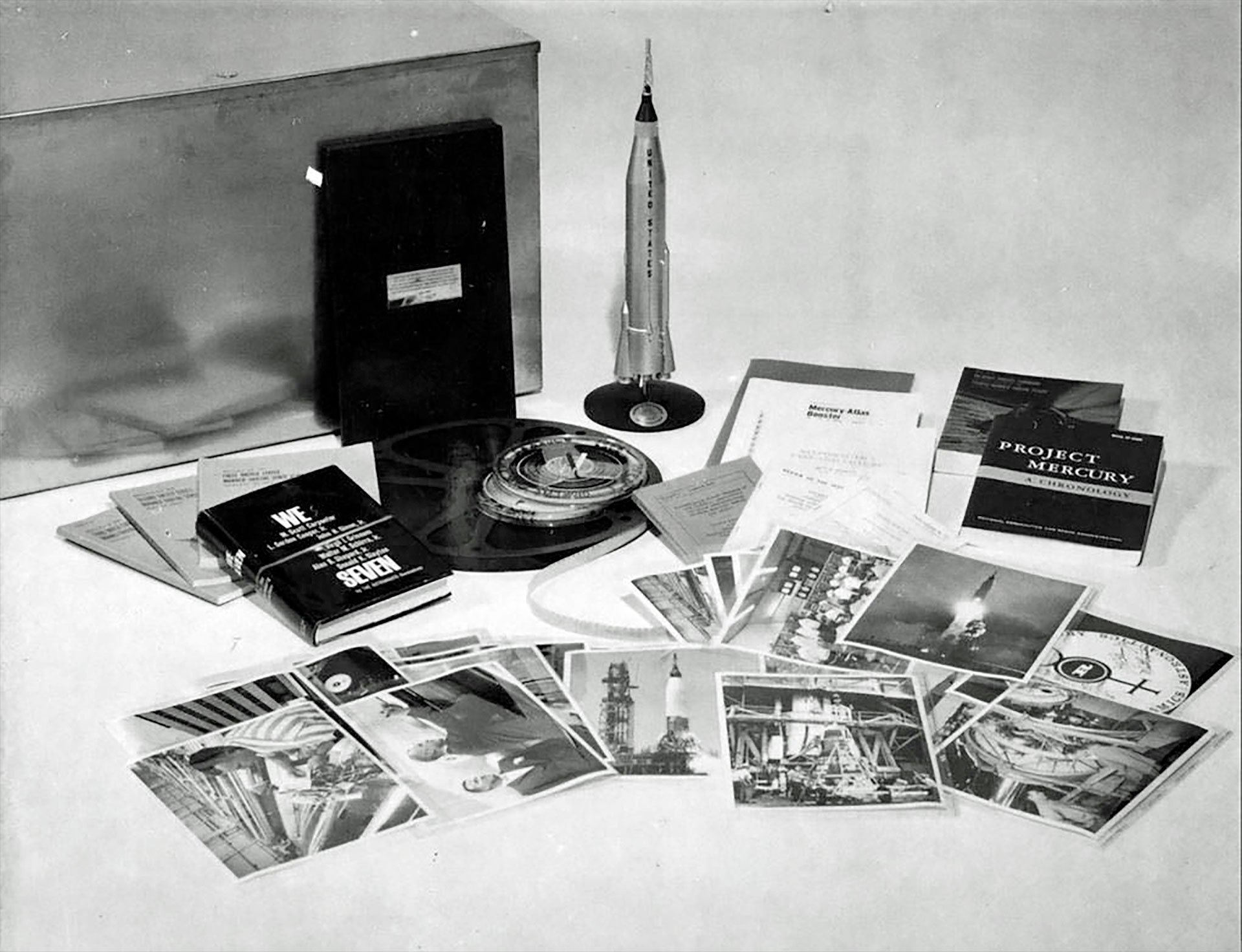
Other examples of each of those items exist outside of the time capsule as well, with many, if not all of the photos, films and documents having been scanned and archived online. One irreplaceable artifact, though, is rumored, but not confirmed, to also be inside.
“According to a document in the UCF [University of Central Florida] archives, ‘contents of the time capsule are said to include John Glenn‘s Marine Corps pilot wings…,’ Draper told collectSPACE. “I have looked at a whole bunch of other sources trying to confirm that, and so far I have been unable to do so. So who knows? It could be in there. It could also be in hands of the family or tucked away in a museum.”
Related: John Glenn: America’s 1st space hero
‘Si Monumentum Requiris Circumspice’
The Cape Canaveral Space Force Museum is today responsible for the care of the monument, but also has support from the station’s cultural resource manager and a historian at nearby Patrick Space Force Base. While the Mercury 7 symbol remains in stable condition and there is nothing that can done about the time capsule, they are monitoring one other component of the 60-year-old installation.
“One of my concerns are the bronze plaques that accompany it. They are showing some surface-level patina damage,” said Draper. “Different bronzes age in different forms and it’s nothing aggressive, but we’ve tried working with our cultural resource manager on some surface treatments.”
As the primary plaque reads, the monument stands 2,200 feet (670 m) west of LC-14. At the time of its dedication 60 years ago, the pad was in the process of being converted from supporting the Atlas rockets that launched astronauts Glenn, Scott Carpenter, Wally Schirra and Gordon Cooper to being used to launch the Atlas-Agena rockets that served as uncrewed targets for the subsequent Gemini program missions.
LC-14 was deactivated in 1967, abandoned in place in 1973 and declared a National Historic Landmark in 1984. Today, after seeing no launch activity for 58 years, the pad is being prepared for use again, this time by Stoke Space, a Washington-based company developing a reusable rocket intended to fly daily.
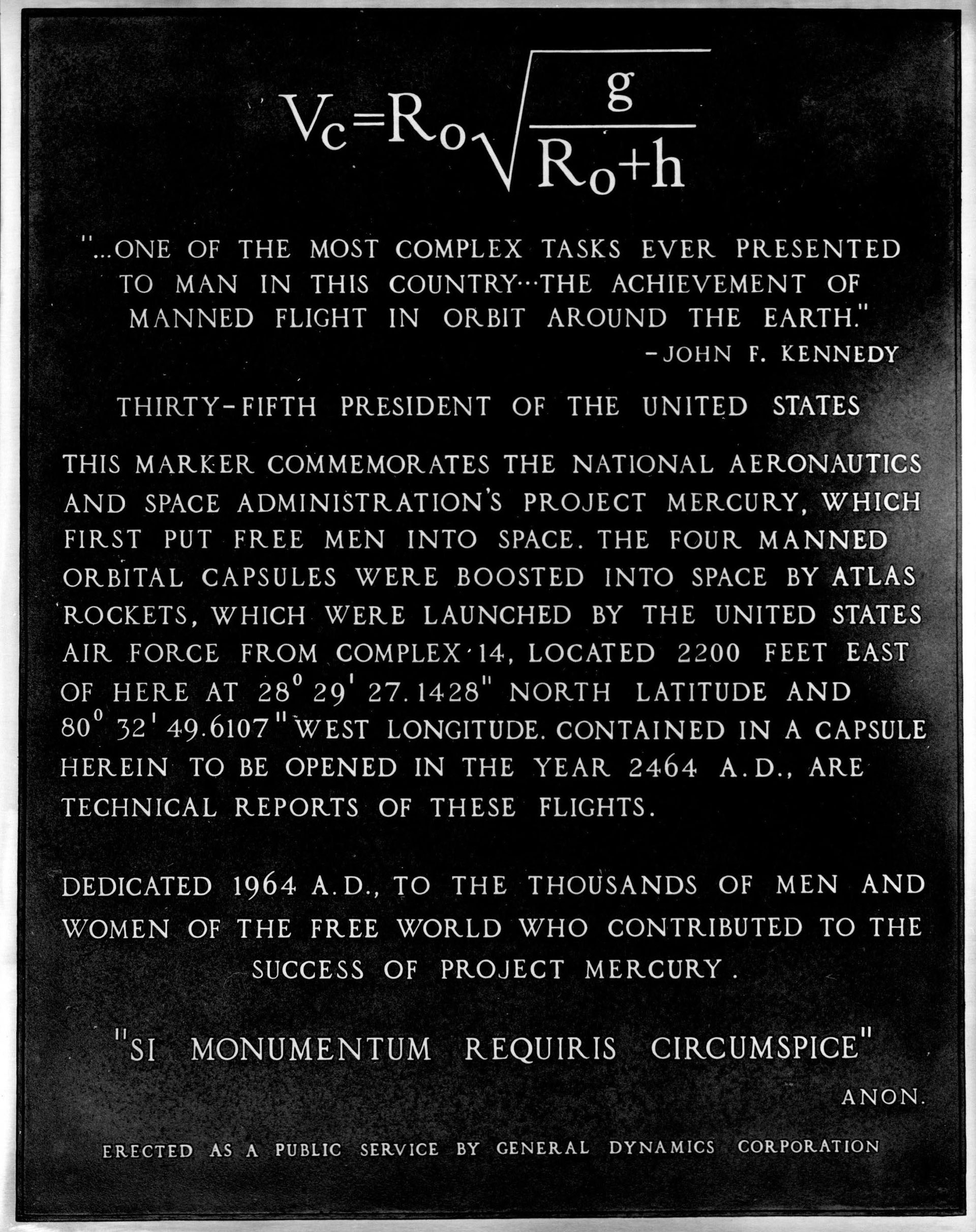
Unlike another historical marker that was located at the base of the LC-14 launch ramp and was recently moved into storage due to the work at the pad, there are no plans to relocate the Project Mercury Monument.
“It is in a fairly protected spot. There is no construction in the works or in the planning stages for that space that I see that could bring the monument or its time capsule into any form of peril,” said Draper. “If something like that does arise, the museum is standing by to take an active role in securing it, either for a move to a safe location, to the museum, or whatever. That is a discussion for another day.”
That is indeed fortunate given the other intention of the Project Mercury Monument, as noted by an inscription in Latin. Borrowed from the tomb of Sir Christopher Wren in St. Paul’s Cathedral in London, “Si Monumentum Requiris Circumspice” translates in English to, “If you seek a monument, look about you.”
The quote serves as a reminder that all of Cape Canaveral is a monument to the nation’s achievements in space, as General Dynamics described in 1964.

Follow collectSPACE.com on Facebook and on X at @collectSPACE. Copyright 2024 collectSPACE.com. All rights reserved.
